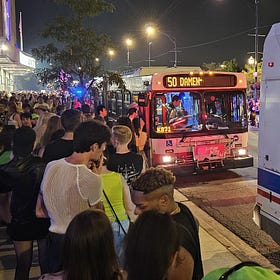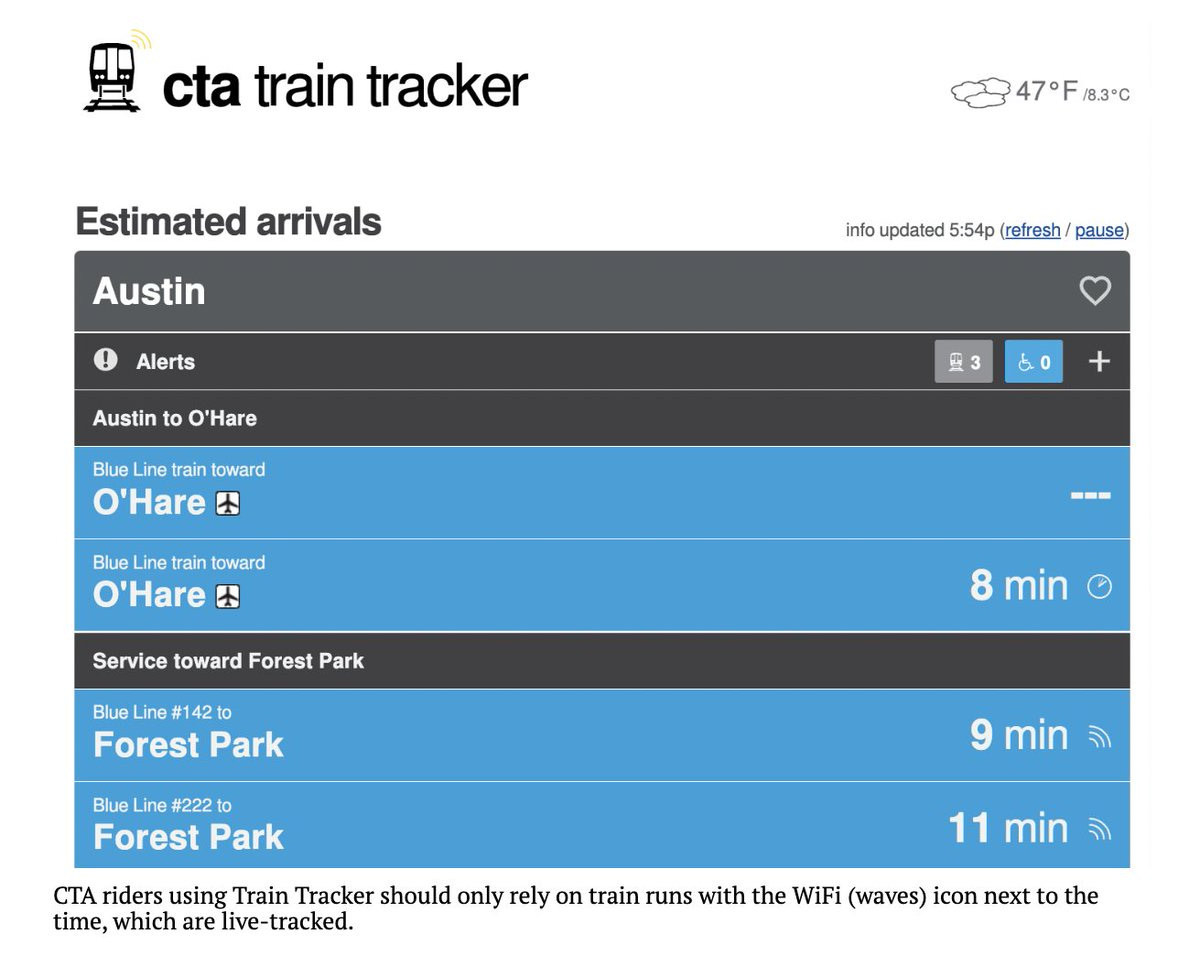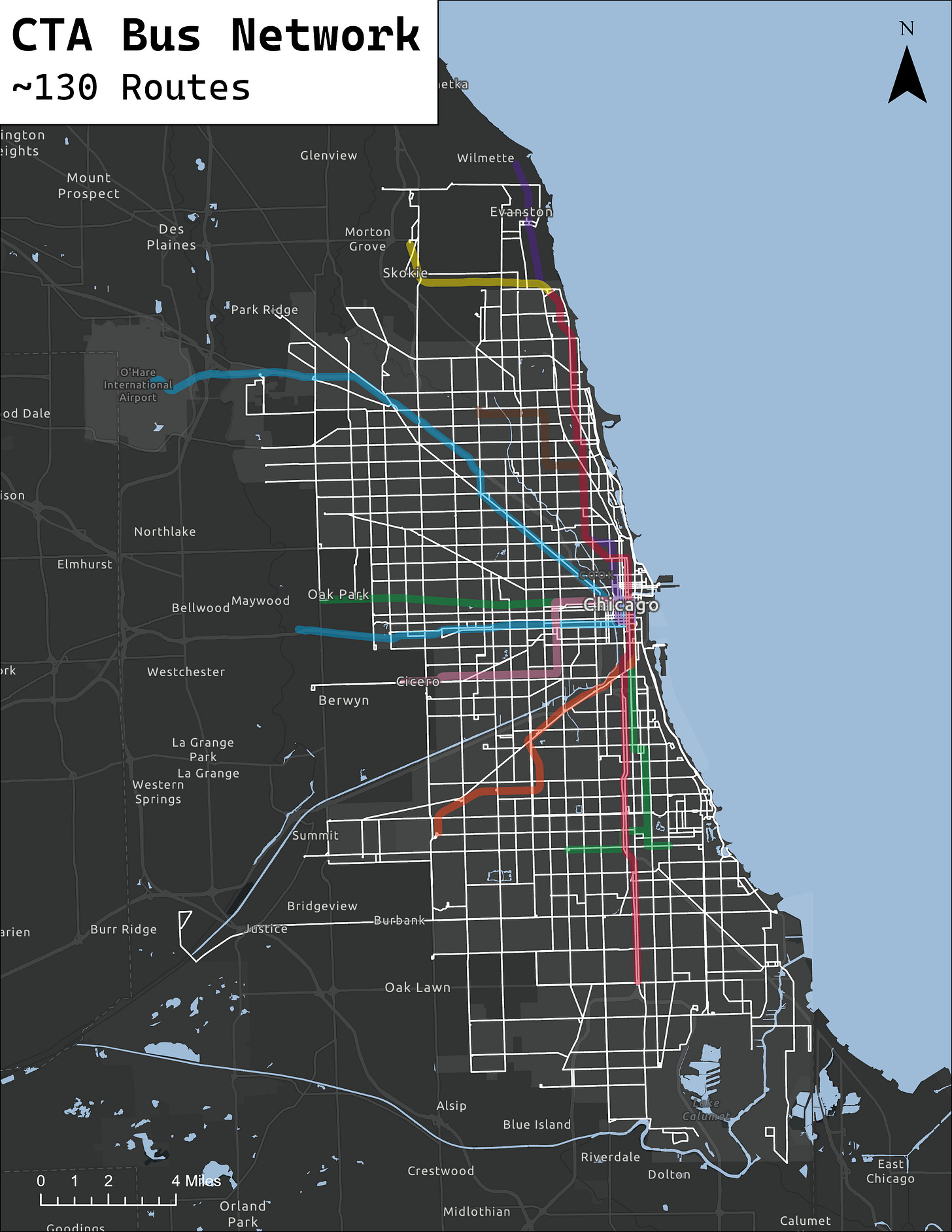A New Era for Chicagoland Transit: Seizing the Moment for a World-Class System
The CTA president retired after 10 years. There's downstate legislation to create a new transit system altogether. A service led approach could mean world-class transit for Chicago and its suburbs.
Times are changing for Chicagoland transit generally
There’s leadership change and lurking governance reform for Chicagoland Transit. Today, trains and buses in Chicago are operated by the CTA, suburban buses and ADA paratransit are operated by Pace, and commuter regional regional rail is operated by Metra. All three of these operators are loosely overseen1 by the Regional Transit Authority. All four of these entities are overseen by a network of board appointments. That’s likely to change soon.
📜HB5823 (Blow it up and rebuild something new)
In April of of 2024, Representative Kam Buckner introduced HB5823 (The Metropolitan Mobility Authority Act) to the Illinois General Assembly. This bill proposes merging CTA, Metra and Pace (as well as the RTA that oversees them all) into one agency; the Metropolitan Mobility Authority (MMA). The MMA would have oversight over planning and service coordination, but the delivery of transit service would be handled by three operating divisions (Suburban bus, commuter rail and Chicago Transit). This agency would be overseen by an 18 member board of directors appointed thusly:
3 Directors appointed by the Governor and approved by the senate
5 Directors appointed by the mayor and approved by the City Council2
5 Directors appointed by the President of the Cook County Board of Commissioners and approved by its board
5 Directors, each appointed by the chairs of of the DuPAge, Kane, Lake, McHenry, and Will County boards and approved by their respective boards
📜SB1938 (Reform what we already have)
In February of 2025, Ram Villivalam introduced SB1938 to the Illinois General Assembly. This bill proposes the establishment of a Road Usage Charge (ostensibly as a replacement to the gas tax), as well as changes to the MMA legislation. Instead of creating a new entity, SB1938 aims to strengthen the RTA by providing it sole responsibly over the management and oversight of fare collection in the region. Additionally, it proposes reducing the fare recovery ratio requirement to 15% from 50%, makes some changes to the existing boards, and establishes a mandate to develop a region wide transit police force and Transit Ambassador Program.
It’s unclear what form legislative change will take, but it is clear that something structural is going to happen, likely within the year. For what it’s worth, I’m for the MMA bill, with the farebox recovery change and the Transit Ambassador Program from the RTA bill3.
Update: On May 31st, 2025, the Illinois Legislature failed to approve transit governance reform or any additional funding support. With a 40% operating deficit anticipated to start in 2026, the future of Chicagoland transit remains uncertain.
Times are changing at the CTA specifically
There’s leadership change at the CTA. On January 13th, 2025. Dorval Carter announced his retirement as President of the Chicago Transit Authority (CTA). On January, 31st he officially stepped down from his position after overseeing the CTA since 2015. Nora Leerhsen, the chief of staff for the CTA, is currently serving as acting president while a permanent replacement is identified. The current CTA board gets to lead this charge.
All of this is occurring against the backdrop of a projected $730-770 million operating budget shortfall for transit in and around Chicago by 2026.
All this volatility can be scary, but it also presents a once in a lifetime opportunity to rethink how transit operates in and around Chicago, and build the world class transit system that Chicago deserves. To achieve this world class system, Chicago needs transit leadership focused on service delivery and the customer experience.
The Last Five Years
The Chicago Transit Authority. The CTA. The L. My home transit system for the past five years.
From their website:
“The Chicago Transit Authority (CTA) operates one of the nation’s largest public transportation systems and covers the City of Chicago and 35 surrounding suburbs. On an average weekday, 765,566 rides are taken on CTA.
Their mission:
“We deliver quality, affordable transit services that link people, jobs and communities.”
The last five years were rough for transit generally, and particularly rough for the Chicago Transit Authority. Let’s get into it.
The Pandemic. (We all lived it, so I’ll do my best keep this brief)
People that could work from home were. This was good for public health, but bad for transit ridership. Here in Chicago, regional transit ridership dropped significantly, with Metra taking the hardest hit. Despite steady recovery, regional transit ridership is still below pre-pandemic levels (you can explore the data here if you’re interested).
Less ridership meant less fare revenue. This was a minor issue for small and midsized transit systems like the Kansas City Area Transportation Authority (KCATA/RideKC) whose farebox recovery ratio was 11% in 2019, and a major issue for large transit systems like the CTA whose farebox recovery ratio was 43% in 2019.
Farebox Recovery Ratio = % of operating expenses covered by fares
To prevent the potential collapse of transit systems across the nation, the federal government stepped in and provided temporary relief funding. For many transit agencies, that relief funding dries up soon. Per the Regional Transit Authority (RTA), “Beginning in 2026, the [Chicagoland transit] system could face a $730 million annual budget gap assuming current service levels are maintained regionwide.”
The Bus Driver Shortage
The pandemic also exacerbated an existing issue for transit authorities; a persistent bus driver shortage. TransitCenter sums it up well in this brief and its accompanying report Bus Operators in Crisis, but stagnating wages and frankly, disrespectful working conditions already made the job a tough sell. Add in the risk of catching a novel, highly contagious and potentially fatal disease, and interest dropped to near zero. Bus drivers that could retire did, and absenteeism spiked amongst the remaining operators (would you want to come to work?). Many transit authorities were forced to cut service to meet staff availability. Some boasted never cutting scheduled service and left the riders to figure out what that meant.
Vehicle Capacity Restrictions
The pandemic also came with vehicle capacity restrictions on buses and trains, a policy well aligned with CDC guidance, but functionally infeasible without structural changes to transit operations.
A note on bus operations: The cost of bus service is driven by the cost of labor. About 71% of the cost of operating bus service in the US in 2023 was wages and benefits. The size of the vehicle operated does not change the cost much. More service means more bus drivers means more expensive.
At its most restrictive, standard (40’) CTA buses could operate with no more than 15 passengers (about 28% full).
Put differently, 3.5 buses were required to carry the load previously carried by 1 bus. Ideally, vehicle capacity restrictions would have come with added service. Married with the existing bus driver shortage, capacity restrictions often meant passengers didn’t know when the next bus was going to show up, and if they were actually going to be able to board the bus when it arrived. This is not Good Transit.
What Is Good Transit?
Recently I was talking with my husband after a bus ride, and he said "that experience was not worth $2.50; I'd rather walk” (not related to the header picture). That obviously made me sad as a transit planner, but after we kept talking (and I got over myself), I realized that he was right. Transit types like me (and probably you if you’re reading this) …
People Experiencing Homelessness
With many social service providers closing their physical locations, transit became shelter of last resort for many people experiencing homelessness, a trend that has continued in the post pandemic years. Chicago’s 2024 Point-in-Time count of people experiencing homelessness found that 46% of the homeless population in Chicago takes shelter on the CTA. Homeless populations come with a unique set of needs that transit authorities are not designed to handle.
A Note on Homelessness: Homelessness is poorly represented and poorly understood in the mainstream, and this is damaging for addressing its root cause (hint: it’s access to housing). If you want to better understand homelessness, I’d recommend the following books.
Homelessness is a Housing Problem by Gregg Colburn and Clayton Page Aldern
The Librarian’s Guide to Homelessness by Ryan Dowd
P.S. - Please say “homeless people” or “people experiencing homelessness” instead of phrases like “the homeless.” This is called “people first language”, and it reminds our brains that these are people experiencing a trauma
So What are Other Places Doing?
In response to these challenges, we’ve seen agencies across the nation take unique and proactive action.
In San Francisco, Bay Area Rapid Transit (BART) launched its Transit Ambassador program, which introduced unarmed, highly visible transit ambassadors and crisis intervention specialists onto BART trains. These staff members, equipped with radios, Narcan, and de-escalation training, walk trains and stations, providing a uniformed presence onboard transit vehicles. Notably, in its first year, less than 1% of the 12,000 interactions made by these ambassadors required police intervention (similar programs exist at SEPTA and LA Metro, with similar outcomes).
In May of 2023, the Minnesota Legislature passed HF2887, which, amongst other things, is expected to generate around $450 million annually for Metro Transit (equivalent to ~99% of their 2023 operating budget).
In November 2024, Governor Josh Shapiro of Pennsylvania directed the state department of transportation to shift $173 million in highway spending to the Southeastern Pennsylvania Transportation Authority (SEPTA) to avert fare increases and service cuts (something that most governors can do, but often don’t).
Here locally, Metra has been making strides to transform its service from a commuter rail model into a regional rail model (less peak oriented service, more all-day service). In pursuit of this, the agency has introduced more off peak service on the Metra Electric Line, added more weekend service on the BNSF Line, and completely restructured their fare policy, reducing the number of fare zones from 10 to 4.
What’s Going On Back in Chicago?
Unfortunately, while its peers have adapted to this new world, the CTA has been markedly unimaginative in its response. Near the beginning of the pandemic, CTA and Lori Lightfoot (the then mayor) boasted that CTA was the only major US city that didn’t cut scheduled transit service (emphasis on “scheduled”). In practice, this meant those still riding transit during the pandemic faced yet another challenge; Ghost buses.
Despite complicated explanations from the CTA about why ghost buses happen, ghost buses are actually pretty simple to understand. Ghost Buses are buses that exist on the schedule, but never come in real life. In short, nobody was scheduled to drive the bus. Ghost buses happened occasionally before the pandemic, but CTA typically ran enough service that the gap was barely noticed. During the pandemic, increased absenteeism and an acute driver shortage meant ghost buses became a common occurrence for CTA riders, making trip planning next to impossible. Riders quickly picked up on this, with some particularly data savvy riders quantifying the difference between scheduled and actual service (here’s a link to that if you want to fall down that rabbit hole).
When presented with criticism, CTA staff maintained a defensive tone, initially denying the issue outright before growing pressure forced them to acknowledge it and issue guidance to only plan trips around real-time arrivals.
Eventually, over a year into the pandemic, the CTA adjusted schedules to meet current operator availability, but not before lasting damage to public trust in the system had been done. This is punctuated by the variety of calls for accountability and reform at the CTA that have cropped up in the years following the pandemic.
Commuters Take Action was established in the post pandemic years as a self-described collective of Chicago transit riders fighting for a reliable, safe, accountable, and accessible CTA. The organization collects rider testimonials, publishes daily reliability data, testifies at CTA board meetings, hosts protests, and more, becoming “a mouthpiece for our fellow frustrated commuters.” Commuters Take Action has become a regular attendee and CTA board meetings.
In March of 2024, 29/50 Chicago aldermen (city councilors) signed a resolution calling for the CTA President Dorval Carter to resign or be fired. Crains Chicago, the Chicago Tribune and the Chicago Sun-Times, have all published editorials advocating for leadership change at the CTA. At an unrelated press conference, J.B. Pritzker, the current governor or Illinois, alluded to the need for leadership change at the CTA. In January 2025, Dorval Carter announced his retirement.
Over the past five years, the Chicago Transit Authority took a big hit to reliability, a core element of Good Transit, and it’s slowing their recovery. When reliability is lost, it’s hard to trust transit. Without trust, transit has nothing. Why would anybody choose to wait at a bus stop for a bus that may or may not come? Whoever leads the CTA (or whatever replaces it) next needs to understand that the path to a world class transit system is paved with a focus on service quality. In this final section, I offer a framework for what a service focused CTA could look like.
UPDATE: Since this was initially published, the CTA has announced its new frequent network, where buses are scheduled to come every 10 minutes between 6am and 9pm4! 🎉
The CTA Key Bus Network
The CTA operates a network of ~130 bus routes in and around Chicago. Because Chicago is one of the most gridded cities in the world, this network provides a remarkable level of coverage.
Within this network, there are a subset of routes identified as “Key Routes”. The CTA Key Routes are shown below,
These Key Routes make up the Key Route bus network. Despite only making up 1/3 of Chicago Transit Authority bus routes, the Key Route network carries 2/3 of CTA bus riders. From the CTA service standards document:
The Key Route bus network was established to ensure that customers across the more densely populated parts of the service area with high transit usage can readily access bus routes meeting more stringent frequency standards.
Routes in the Key Route network are typically spaced one mile apart, which allows for approximately a 1/2-mile journey to reach a route in this network.
The vehicle headway standard for the Key Route bus network is to operate at least every 10 minutes during the weekday peak periods, 15 minutes during the weekday midday period, 20 minutes during the weekday evening period, 15 minutes on Saturday afternoons and 20 minutes on Sunday afternoons.
Key routes get prioritized in planning (they get more service), but they don’t get any priority in staffing.
A note on how transit service is staffed
Seniority is a big deal in bus garages. So much so that it’s typically written into union contracts. When bus drivers pick the route they’re going to drive for the next few months, they generally do it in descending order, starting with the most senior driver.
A persistent bus driver shortage means that it’s not uncommon to run out of bus drivers before running out of shifts to cover. In this context (and just generally), Key Routes should be fully staffed long before that impasse is reached. This approach is not without its challenges (namely, union negotiations, and ensuring other routes get adequate coverage), but it maintains reliability, which is integral to Good Transit. Even better, this approach aligns with how passengers consume CTA service. Despite making up about 1/3 of the CTA bus network, the key network carries about 2/3 of all bus ridership. Nine of the 10 busiest bus routes in September 2024 were key routes. Even better still, since the city has a near perfect grid, the key route network still maintains a high level of coverage.
A passenger with more flexibility in their travel can wait for a closer support route with reduced reliability, but they could also make their way 10-15 minutes to the nearest key route and connect to the more reliable key bus network. Not perfect, but at least you can plan around it.
So What do we do now?
Better leveraging the key bus network could have been an invaluable tool for the Chicago Transit Authority in preserving systemwide reliability during the pandemic and in the years that have followed. Missed the bus on that one. However, there is an old proverb that says, “The best time to plant a tree is 20 years ago. The second best time is now”. Today is a great day to start leveraging the key network and rebuilding public trust in the CTA.
We already know that 1/3 of routes carry over 2/3 of systemwide bus ridership. Let’s make sure the routes that the most Chicagoans encounter represent Good Transit. That means:
Ensuring these routes are fully and reliably staffed
Ensuring buses move quickly on these routes. The Better Streets for Buses plan developed a toolbox of transit priority treatments to be used throughout the CTA network to speed up buses
Actually enforce the transit priority treatments that currently exist (Check out any bus lanes outside of the loop during rush hour if you’re bored)
Space bus stops appropriately (every 1/4 mile) on these routes. The CTA service standard sets the minimum spacing at every 1/8 mile
Support higher density, walkable developments with reduced (or eliminated) onsite parking along these routes. The Connected Communities Ordinance passed in 2022 provides more latitude for this type of development.
Chicago is a world class city. It deserves world class transit. With new leadership focused on service delivery, I think that vision can be realized.
The RTA requires a supermajority to do anything
One of these members must be the Commissioner of the Mayor’s Office for People with Disabilities
The Road Usage Charge is good policy, but It belongs in its own piece of legislation.
9am-9pm on weekends














